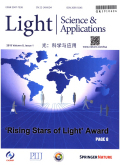- 钛学术文献服务平台 \
- 学术期刊 \
- 工业技术期刊 \
- 电工技术期刊 \
- 光:科学与应用(英文版)期刊 \
Non-linear self-driven spectral tuning of Extreme Ultraviolet Femtosecond Pulses in monoatomic materials
Non-linear self-driven spectral tuning of Extreme Ultraviolet Femtosecond Pulses in monoatomic materials
基本信息来源于合作网站,原文需代理用户跳转至来源网站获取
摘要:
Self-action nonlinearity is a key aspect–either as a foundational element or a detrimental factor–of several optical spectroscopies and photonic devices. Supercontinuum generation, wavelength converters, and chirped pulse amplification are just a few examples. The recent advent of Free Electron Lasers (FEL) fostered building on nonlinearity to propose new concepts and extend optical wavelengths paradigms for extreme ultraviolet (EUV) and X-ray regimes. No evidence for intrapulse dynamics, however, has been reported at such short wavelengths, where the light-matter interactions are ruled by the sharp absorption edges of core electrons. Here, we provide experimental evidence for self-phase modulation of femtosecond FEL pulses, which we exploit for fine self-driven spectral tunability by interaction with sub-micrometric foils of selected monoatomic materials. Moving the pulse wavelength across the absorption edge, the spectral profile changes from a non-linear spectral blue-shift to a red-shifted broadening. These findings are rationalized accounting for ultrafast ionization and delayed thermal response of highly excited electrons above and below threshold, respectively.

推荐文章
一种基于用户行为的Self集构造和演化方法
计算机免疫
演化计算
计算机安全
入侵检测
Detection of foreign materials on surface of ginned cotton by hyper-spectral imaging
hyper-spectral imaging
ginned cotton
foreign materials
detection
内容分析
关键词云
关键词热度
相关文献总数
(/次)
(/年)
文献信息
| 篇名 | Non-linear self-driven spectral tuning of Extreme Ultraviolet Femtosecond Pulses in monoatomic materials | ||
| 来源期刊 | 光:科学与应用(英文版) | 学科 | |
| 关键词 | |||
| 年,卷(期) | 2021,(6) | 所属期刊栏目 | Letters |
| 研究方向 | 页码范围 | 950-956 | |
| 页数 | 7页 | 分类号 | |
| 字数 | 语种 | 英文 | |
| DOI | |||
五维指标
引文网络
引文网络
二级参考文献 (0)
共引文献 (0)
参考文献 (31)
节点文献
引证文献 (0)
同被引文献 (0)
二级引证文献 (0)
1970(1)
- 参考文献(1)
- 二级参考文献(0)
1985(1)
- 参考文献(1)
- 二级参考文献(0)
1992(1)
- 参考文献(1)
- 二级参考文献(0)
2000(1)
- 参考文献(1)
- 二级参考文献(0)
2004(1)
- 参考文献(1)
- 二级参考文献(0)
2009(1)
- 参考文献(1)
- 二级参考文献(0)
2010(1)
- 参考文献(1)
- 二级参考文献(0)
2011(1)
- 参考文献(1)
- 二级参考文献(0)
2012(2)
- 参考文献(2)
- 二级参考文献(0)
2013(6)
- 参考文献(6)
- 二级参考文献(0)
2014(2)
- 参考文献(2)
- 二级参考文献(0)
2015(2)
- 参考文献(2)
- 二级参考文献(0)
2017(3)
- 参考文献(3)
- 二级参考文献(0)
2018(3)
- 参考文献(3)
- 二级参考文献(0)
2019(5)
- 参考文献(5)
- 二级参考文献(0)
2021(0)
- 参考文献(0)
- 二级参考文献(0)
- 引证文献(0)
- 二级引证文献(0)
引文网络交叉学科
相关学者/机构
期刊影响力
光:科学与应用(英文版)
主办单位:
中国科学院长春光学精密机械与物理研究所
出版周期:
双月刊
ISSN:
2095-5545
CN:
22-1404/O4
开本:
出版地:
吉林省长春市东南湖大路3888号
邮发代号:
创刊时间:
语种:
eng
出版文献量(篇)
762
总下载数(次)
0
总被引数(次)
112
期刊文献
相关文献
推荐文献
- 期刊分类
- 期刊(年)
- 期刊(期)
- 期刊推荐
一般工业技术
交通运输
军事科技
冶金工业
动力工程
化学工业
原子能技术
大学学报
建筑科学
无线电电子学与电信技术
机械与仪表工业
水利工程
环境科学与安全科学
电工技术
石油与天然气工业
矿业工程
自动化技术与计算机技术
航空航天
轻工业与手工业
金属学与金属工艺
光:科学与应用(英文版)2022
光:科学与应用(英文版)2021
光:科学与应用(英文版)2020
光:科学与应用(英文版)2019
光:科学与应用(英文版)2018
光:科学与应用(英文版)2017
光:科学与应用(英文版)2016
光:科学与应用(英文版)2021年第9期
光:科学与应用(英文版)2021年第8期
光:科学与应用(英文版)2021年第7期
光:科学与应用(英文版)2021年第6期
光:科学与应用(英文版)2021年第5期
光:科学与应用(英文版)2021年第4期
光:科学与应用(英文版)2021年第3期
光:科学与应用(英文版)2021年第2期
光:科学与应用(英文版)2021年第12期
光:科学与应用(英文版)2021年第11期
光:科学与应用(英文版)2021年第10期
光:科学与应用(英文版)2021年第1期

 免费查重
免费查重










